By Steve Cary, August 2021
We have a lot of highlights to cover this month, seeing as we have gone from 0 to 100 bph (butterflies/hour) in the space of only a few weeks. I’ll kick off this mid-August post with a brief narrative of my quick, low-key outing to Harding County in search of Dotted Checkerspot (Poladryas minuta). Christopher Rustay and I have chuckled that, based only on distribution maps, one might conclude that Harding County is completely devoid of birds or butterflies. Turns out that’s because there are no observers, don’t you know.
Ralph Moore told me of his May 2021 adventures in the Texas Panhandle in which Dotted Checkerspot was a highlight. He even loaned some photos to spruce up the account for that species in Butterflies of New Mexico, which displayed rather sad scans of my slides from about 20 years ago and looked less than ideal. I longed to see that butterfly again and get digital photos myself. Then on a recent Friday evening listening to music by the band March Fourth at the Santa Fe Railyard, Marcy and I ran into friends Randy and Paige. The previous week they had camped and hiked at Mills Canyon campground in the Kiowa Grasslands of western Harding County. They said it was very green. That removed any doubts I may have had.
It was a 2.5-hour drive from Santa Fe to Roy. From there it was about 10 miles north to Spear Hills, which are on a section of state trust land and thus accessible to members of the public who possess an annual recreational use permit from the State Land Office. I have such a permit and you can get one, too. I sought hills because Dotted Checkerspot is a hilltopper. This part of Harding County has only little volcanic bumps, but those should be sufficient.
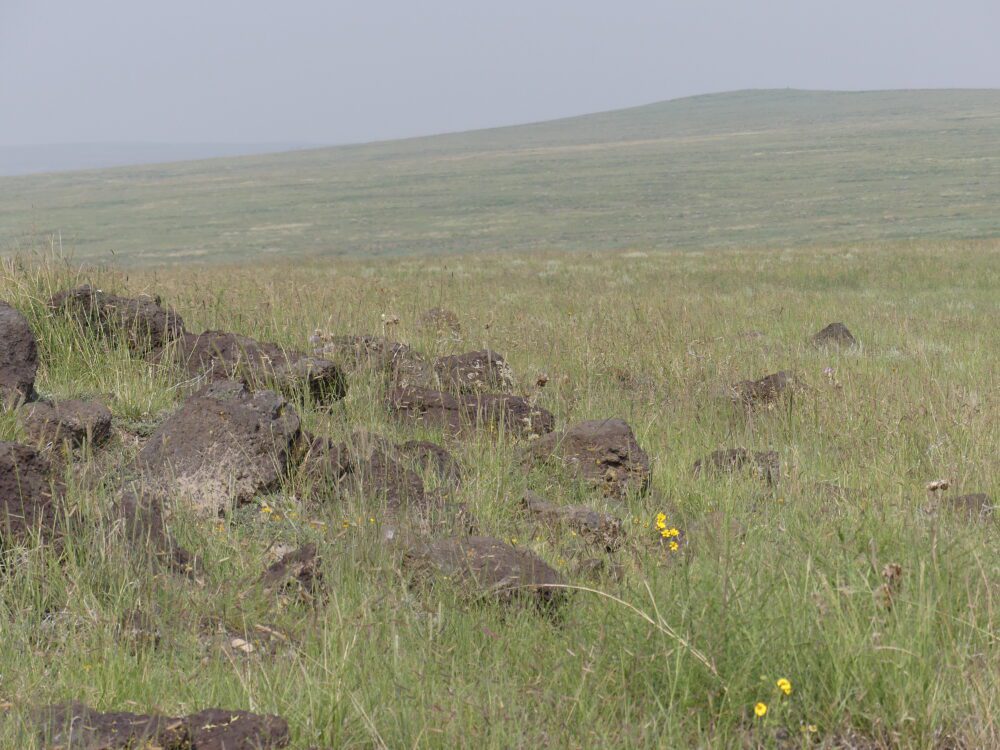
It was a smoky morning and the sun struggled to warm things up. Finally, at 10 AM, I saw a Fulvia Checkerspot basking on a small ledge of volcanic basalt. Then an Uncas Skipper buzzed over to a purple thistle. Finally, a Dotted Checkerspot appeared and spread its wings to bask! It was a worn male (see below), but at least it confirmed that the second brood of the year was in flight and my visit was well-timed.
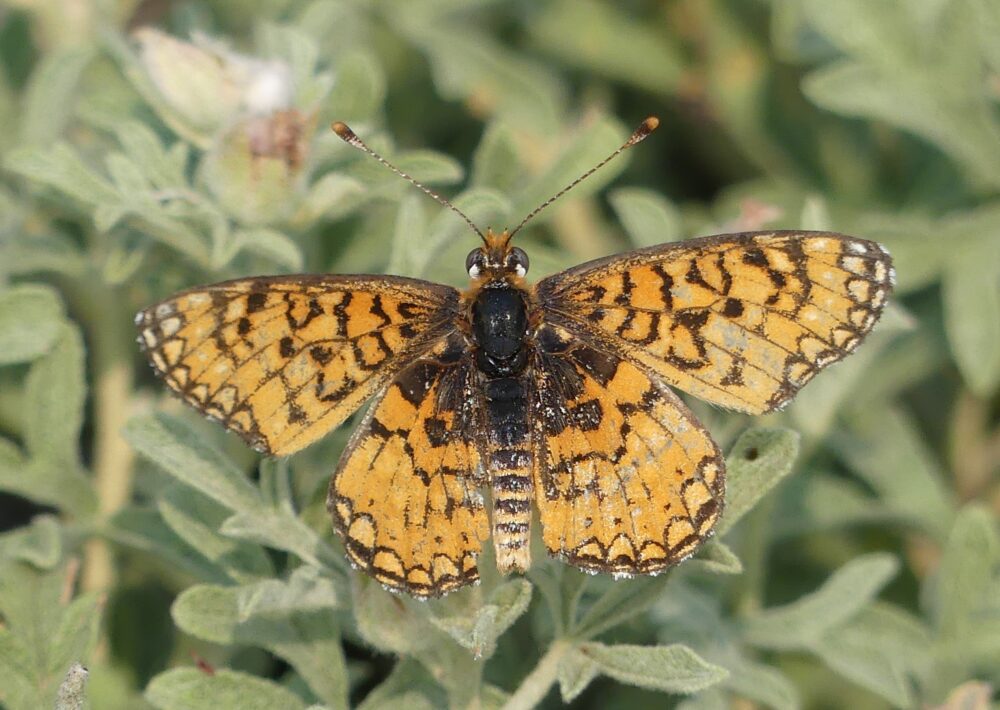
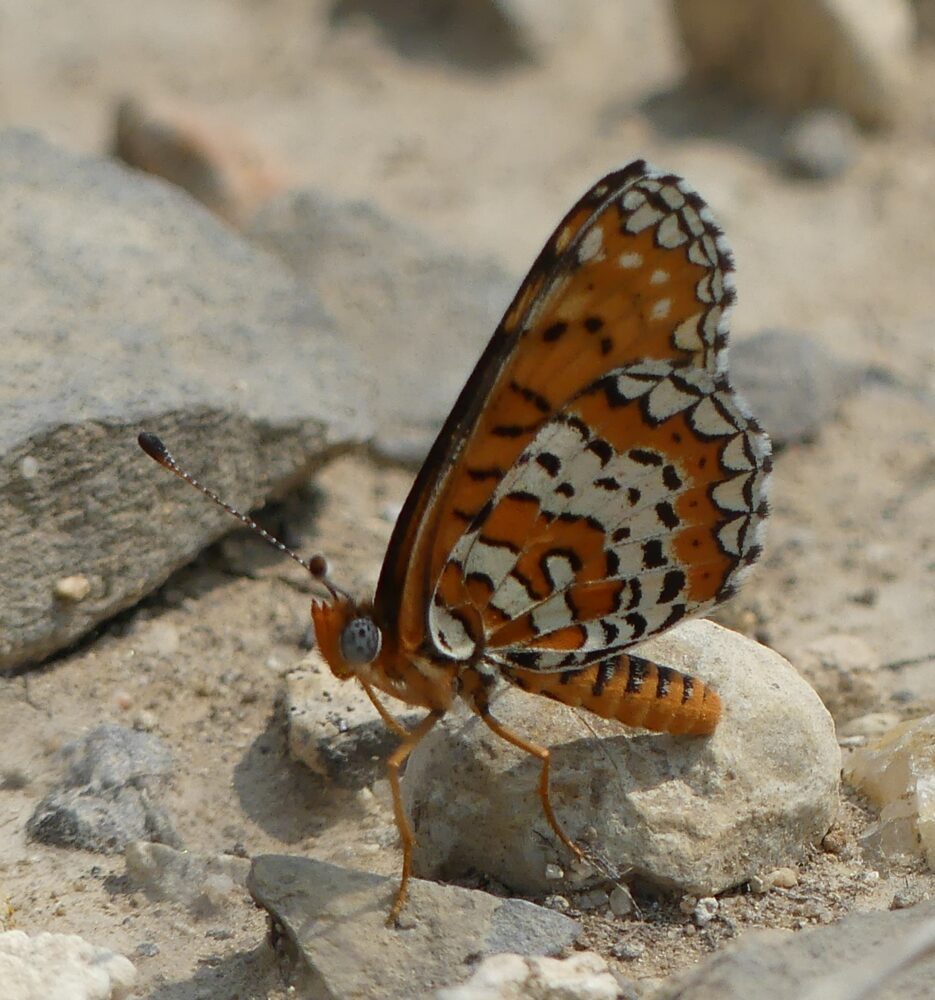
I slowly walked the gentle summit of that and the next hill, the morning air warming and clearing as I went. I saw another Dotted, then I saw a person approaching me from two large cylindrical water tanks. He was a big guy, dressed in camouflage and carrying a compound bow. I waved. He waved. I walked toward him, brandishing my Panasonic Lumix camera. We greeted each other and he explained that he was on a seven-day antelope hunt. His blind was over by the water tanks and my arrival seemed to have spooked the large buck (bull?) he had his eyes on. A similar event had occurred for him a couple days earlier. A nice enough fellow, his frustration was apparent. I could empathize, as I, too, have had to watch as my own target species were spooked. He saw that pronghorn beginning to head his way again and I had another place to visit anyway, so we shook hands and parted. He took a circuitous route back to his a blind. With my mission accomplished, I took a roundabout path back to my truck, then eased back out the way I drove in. Spear Hills would be a fun place to visit at other times of year, when other species are flying, and perhaps not during hunting season.
My second and final stop on this uncomplicated day was nearby, west of Mills and near Mills Canyon Campground, which the Cibola National Forest had recently converted from a very free-range camping area to a more civilized campground. I drove a couple miles west of Mills and headed toward the Canadian River Canyon — the major destination in this area. En route I stopped to investigate a roadside patch of nectar. I followed the nectar to the top of a very small rise on the chance it would have hilltoppers and sure enough, multiple fresh Dotted Checkerspots were perching and patrolling on the barely discernable summit. So I spent some time there, mostly sitting on the ground trying to be inconspicuous so the checkerspots could maneuver at will. When they landed, I scooted over for photos. it was near mid-day and hot, so there was no dorsal basking; instead, they perched with wings closed to minimize their sun exposure.
I saw a blue of some kind, too, but it evaded me. Then, as I cast my eyes up and toward the north, I could see a whole south-facing hillside that was buckwheat central. I walked over and spent about an hour walking in, around, and through the buckwheat. It looked to be Antelopebrush (Eriogonum jamesii v. jamesii), a popular caterpillar hostplant for various blues and metalmarks. I photographed every little thing I could, expecting primarily Western Square-spotted Blue, but in the end I saw only one or two of those. Instead, most of the blues were members of the Acmon/Lupine Blue confusion. This will be a place to get back to, absolutely!
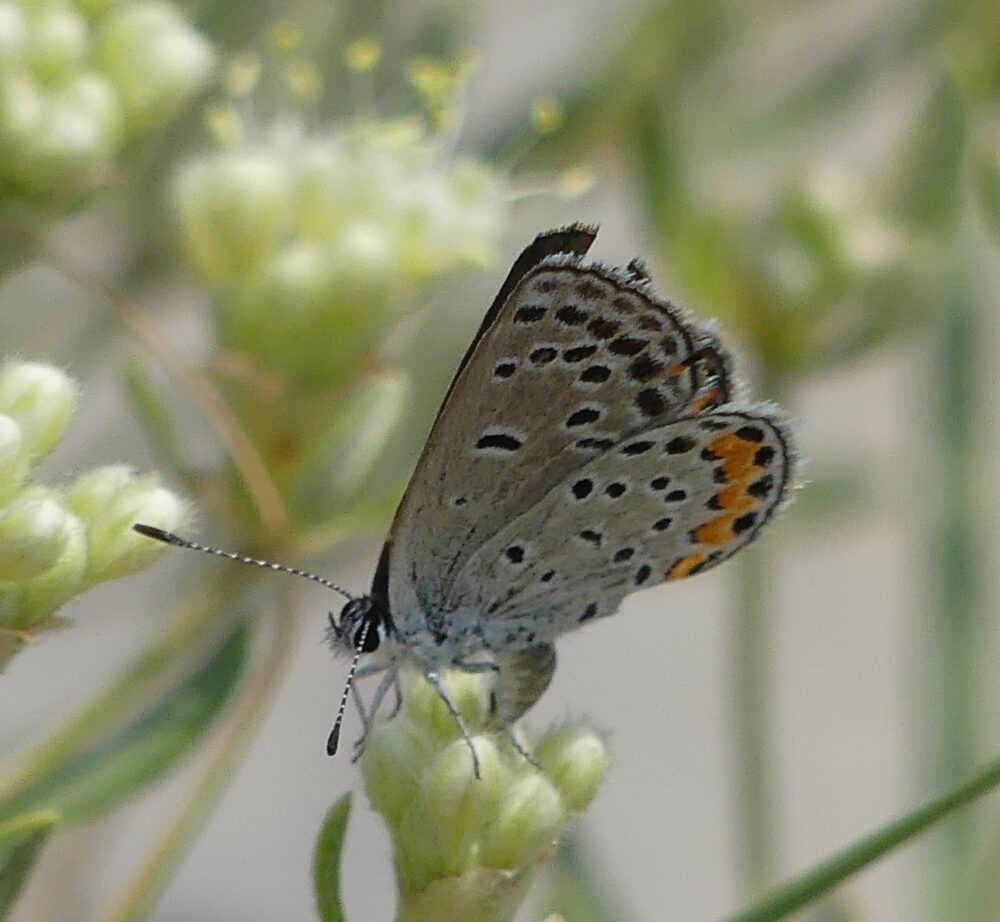
Now for the real mid-summer highlights, but there are so many . . . where do I start? Last year, it was Buckeyes everywhere: Gray and Dark. This year, significant rain has been falling in much, though not all, of New Mexico. Drought conditions are backing off in many places. Remarkably lush conditions prevail in other places. There have been plenty of excellent butterfly days over the past month, so read on for some cool critters.
For example, the Sandia Mountains may not strike one as a place to find exotic or unusual butterflies. It may be the most butterflied mountain range in New Mexico, being near our largest city, with a large university, and having an international airport through which naturalists fly in and out. The first place visiting butterfliers go is to the Sandias, although usually in spring to see Sandia Hairstreak. And what city was home to two of our most prominent modern lepidoptersts? Between the two of them, Mike Toliver and Richard Holland spent significant time and effort butterflying the Sandias from the 1960s to the 2000s. No other area in New Mexico is as well studied for butterflies.
So it was with a doubtful attitude that, wearing my BAMONA hat for review and approval of submitted New Mexico sightings, that I recently opened an August 11 sighting from Joshua C’deBaca way up in Embudito Canyon. His photos suggested Mead’s Wood-nymph (Cercyonis meadii), but even he was dubious, thinking perhaps it was a variant of the more routine Common Wood-nymph (Cercyonis pegala), of which he had seen quite a few. Skepticism was an appropriate attitude for a critter that I could not recall ever being reported from the Sandias or from Bernalillo County. But check the image below yourself — it is Mead’s Wood-nymph. As far as I was able to ascertain, the only other record for that critter in that mountain range or county goes back to Dick Holland, who on August 8, 1968, (53 years earlier almost to the day) captured a female in copula with a male Common Wood-nymph, “near Embudito Canyon” no less. Inter-species matings are rare and often stem from difficulty in finding a conspecific mate. I suppose desperate times call for desperate actions. Mead’s is a beautiful butterfly and kudos to Joshua for seeing it for what it was. One does wonder, however – it does not migrate or wander, so it must be breeding there . . . why is it not reported more often from that much-butterflied area?
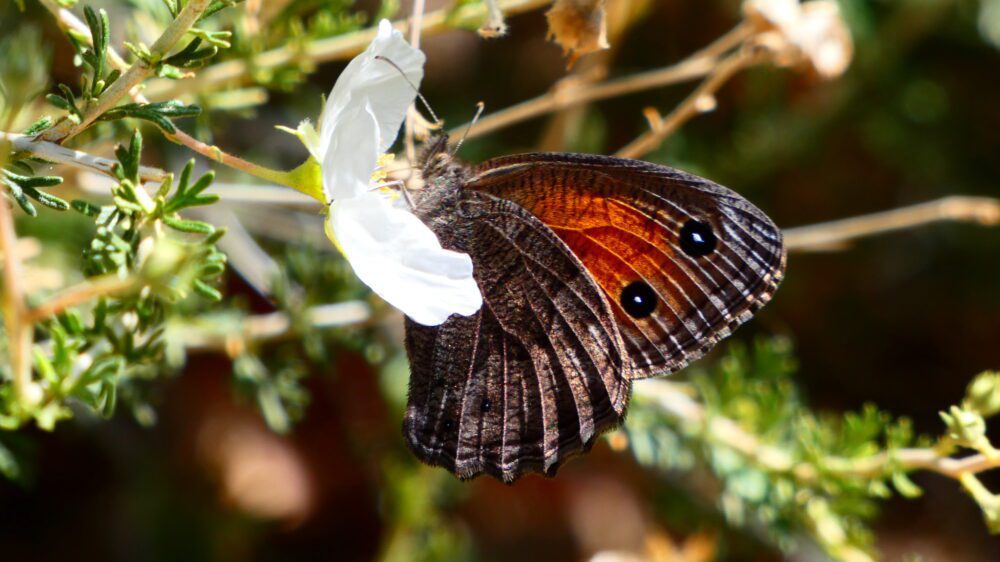
Joshua also had a second wowzer butterfly — an aberrant crescent with a bunch of extra melanin, a dark pigment. We looked over several of his images, including stills from a video he shot. Crescents are a challenging group in which correct IDs sometimes hinge on a few minor, if consistent, marks or patterns. In this case the extra black pigment blotted out several of those diagnostic elements. Even for the features that seemed relatively normal on this individual, I wonder if they really were normal after all. My best guess was Field Crescent, based in part on altitude and time of year. The underside also looked like one of the two forms Field Crescent expresses, but crescent undersides can be misleading. Joshua suggested that the orange tips of the antennal knobs might rule out Field Crescent, per the Brock & Kaufman guide. I sent a couple of Joshua’s images to colleague Mike Fisher in Colorado and he confirmed it as an aberrant Field Crescent, an aberration he had seen himself in Colorado.
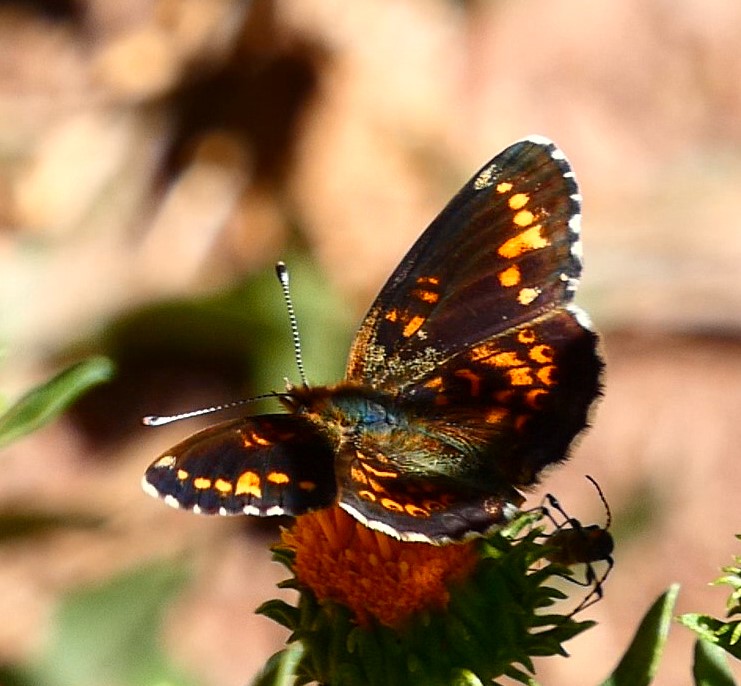
In Las Cruces this summer, there have been several sightings of Gulf Coast Fritillary (Dione incarnata, or Agraulis vanillae in some guides). In the photos that follow, Marta Reece documented its life history as it completed a summer generation there. In her first photo below, you may wonder what happened to this female’s abdomen. Very likely she was placing an egg on passionvine, its host plant. That tropical plant is not native to New Mexico, but it is often planted in southern New Mexico flower gardens and thus is available for seasonal breeding should a female Gulf Coast Fritillary wander by, which they do from time to time.
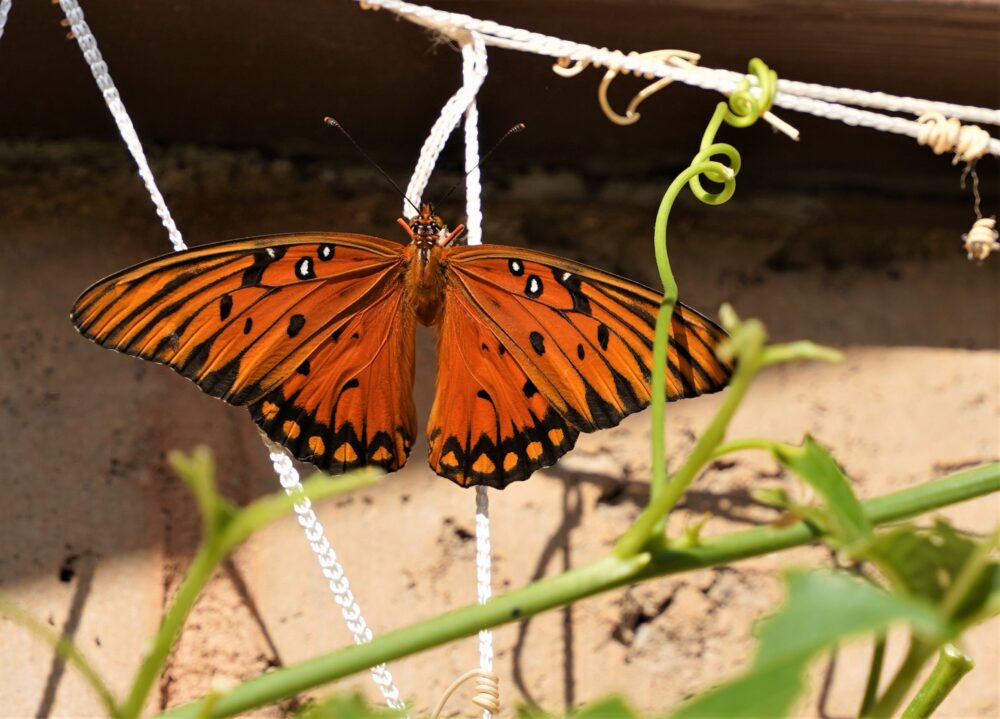
Over the next couple of weeks, Marta followed up on her discovery. Soon she found caterpillars.

A small Gulf Coast Fritillary caterpillar, upper left, munching its way though passionvine protoplasm. (Photo by Marta Reece). 
Gulf Coast Fritillary late stage larva. Las Cruces, Dona Ana Co., NM; July 31, 2021. (Photo by Marta Reece) 
A spent female Gulf Coast Fritillary and a rapidly growing larva. Mother and child? (Photo by Marta Reece) 
Male Gulf Fritillary, right out of the chrysalis. (Photo by Marta Reece)
By August 12, Marta concluded that for her patch of Gulf Coast Fritillaries, “The season here is pretty much over. The passionvine has been destroyed and the adults emerged and left. But that all may be temporary, too.” Wise words indeed; they don’t call it a life cycle for nothing. Those adults may be flying north as we speak, and perhaps there is a fresh passionvine a few blocks over, or maybe in Alamogordo. They may be able to squeeze in another generation before winter cold shuts them down. Thank you, Marta, for elegantly documenting and generously sharing this story and for helping us better understand the life cycle of a very cool butterfly!
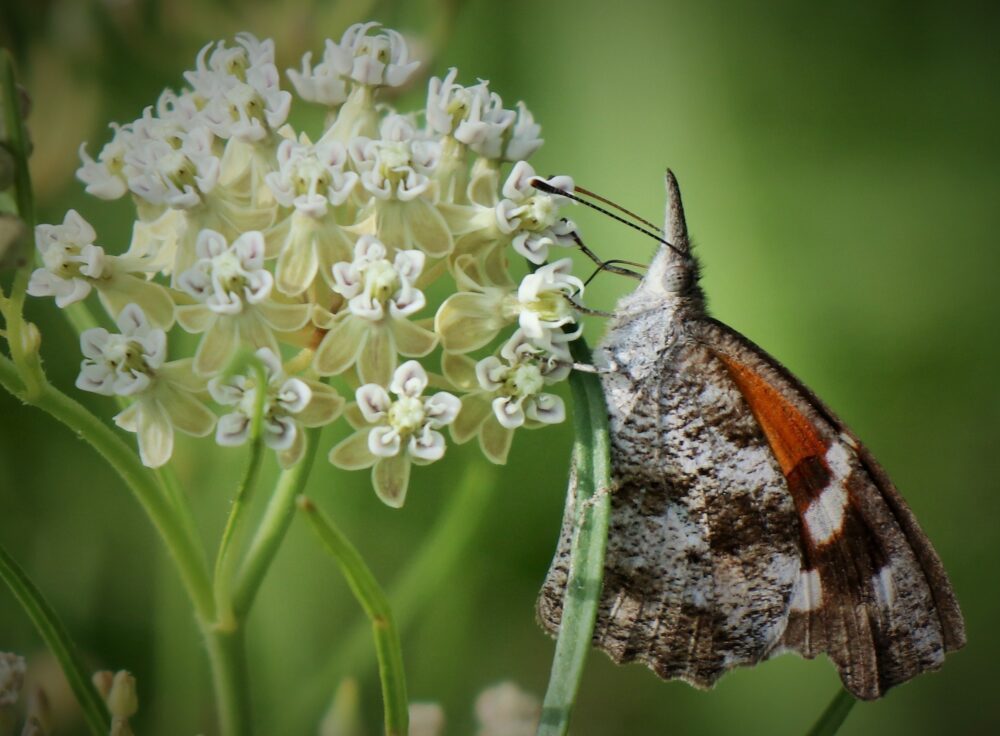
Speaking of southern or subtropical species that sometimes wander or stray northward, American Snouts seem to be having a good summer. When I saw a couple as far north as Maxwell and Sugarite Canyon State Park, both Colfax County, I suspected bigger numbers farther south. Then Las Cruces-based Jim VonLoh wrote to me as follows: “Until last year, I had never encountered or even known there was a butterfly called an American Snout. However, this year I have observed many of these small butterflies on the moist bank of a small retention pond at the Dripping Springs Natural Area Visitor Center last month and near the confluence of the arroyos in Soledad and Bar canyons. To give you an idea about their habitat preference, I left yesterday morning resolute to acquire a better dorsal wing view of a hackberry emperor . . . Instead, I saw few emperors and many, many snouts that were nectaring on catclaw acacia flowers and sunning and seeking mates among the hackberry shrubs and small trees.” Arizona’s Matt Brown claims there are rivers of Snouts in southern Arizona. Here they come!
Every year the mix of subtropical wanderers is a little different. While Snouts and Gulf Coast Fritillaries are often in the northbound influx, this year we’ve already seen some extremely unusual vagrants. For example, last month, Rob Wu photographed a Florida White in the Organ Mountains . . . only the second sighting ever for New Mexico. Below is the first-ever photograph of this species in New Mexico, and a fine photo it is. Thanks, Rob!

. . . and while we’re still in Las Cruces, local butterflyer Judy Lazarus Yellon explained that their local Audubon chapter “added a sort of sub-division relating to butterflies. Rob [Wu] gave an outstanding presentation via Zoom months ago. CJ ]Goin] and I agreed that with the increase in sightings that we should offer to lead butterfly field trips. So CJ has offered to lead such a hike this coming Saturday at Mesilla Valley Bosque State Park, and Fred and I have offered to lead a hike on the 20th at Mesilla Dam, where we have gone most frequently. Hopefully, we will get additional people interested in what they can learn by paying more attention to butterflies.” Las Cruces has a wonderful nucleus of birders, butterflyers, naturalists, watchers, and photographers — and butterflies! It is very exciting to see people coming together to observe, explore, learn and share butterfly experiences.
Have there been any interesting swallowtails this year? As a matter of fact, yes indeed there have! Take a look at this strange version of a very familiar species. It is another aberrant individual with a bunch of excess melanin. Consultations with knowledgeable experts such as Mike Fisher indicated that nothing like this strange creature has ever been seen. Can you guess its identity without reading the caption?
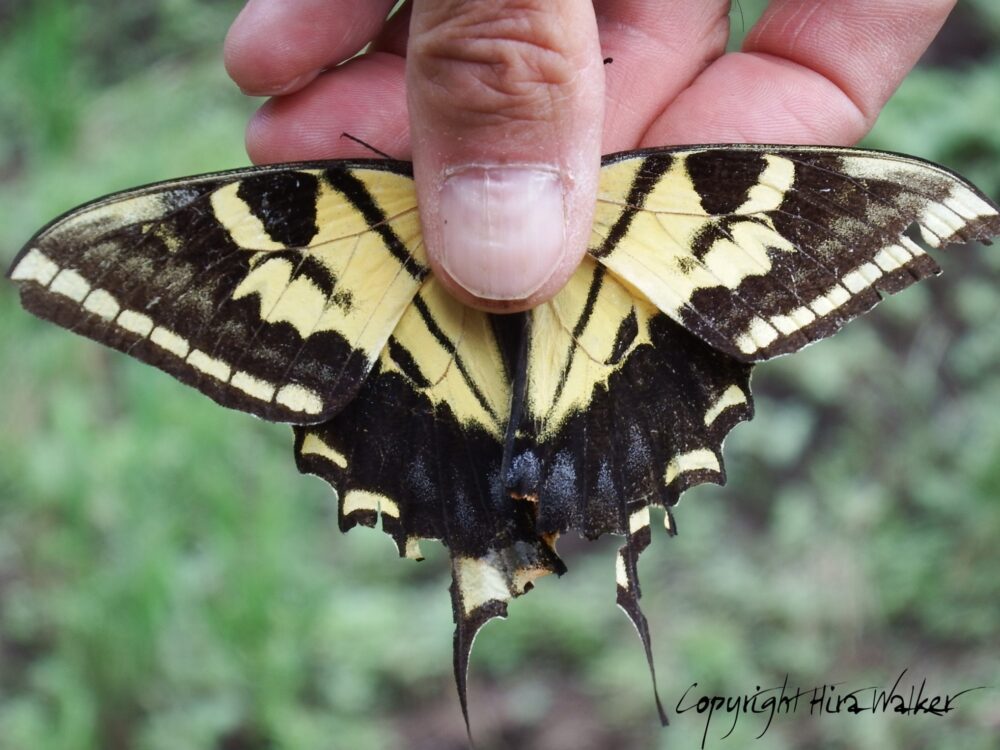
It is rare and unusual to see Ornythion Swallowtail in New Mexico, but that’s just what Jan Richmond did. Her iNaturalist post from Hillsboro, caught the eye of the Black Range’s local all-around naturalist Bob Barnes, who reached out to share it with me. Jan’s is only the fourth sighting ever in New Mexico for this subtropical species. Hers (below) are the first photographs in nature from New Mexico. Nice work, Jan, and thanks for sharing! See more in the updated account for Ornythion in PEEC’s Butterflies of New Mexico.
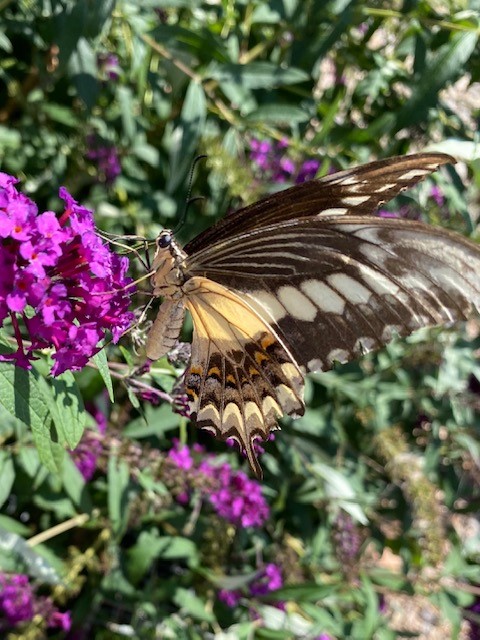
and here’s yet another swallowtail doozy . . . Bob Friedrichs found Indra Swallowtail near Questa! This is only our third confirmed New Mexico sighting of this species and his are only the first in-nature photographs from New Mexico. What is most surprising is that this is not a rare tropical vagrant, but a breeding resident species! Why have we not seen it more routinely before? Well, I suppose we have not been looking in the right place. It’s as simple as that. Bob’s fabulous photographs document a new southeastern outpost for this classic western species. Public accessibility of this location invites us to revisit the area in future years and to make all efforts necessary to fully document the life history of this beautiful swallowtail. Do your research by checking the updated account for Indra Swallowtail in PEEC’s Butterflies of New Mexico. Make your plans for next year. That’s what I’m doing.

Alas, it has not been “butterflies-a-blazing” everywhere. Elaine Halbedel, savant of southwestern New Mexico, found lush conditions, abundant flowers after monsoon rains, yet the butterflies were not similarly abundant: “The monsoons in SW NM have been both frequent and productive, reminding me of what formerly was considered to be ‘normal’ conditions. Unfortunately, that has actually made it somewhat harder to find leps since one needs to find a sunny day in which to observe, as well as a place to go which is not inundated with mud or water. Flowers have exploded in number, but curiously, butterfly species have not — which is not to say that those species flying are not abundant. This has been a PHENOMENAL year for NW Fritillaries . . . as well as for Four-spotted Skipperlings, both of which had become the most abundant butterflies in their niches.”
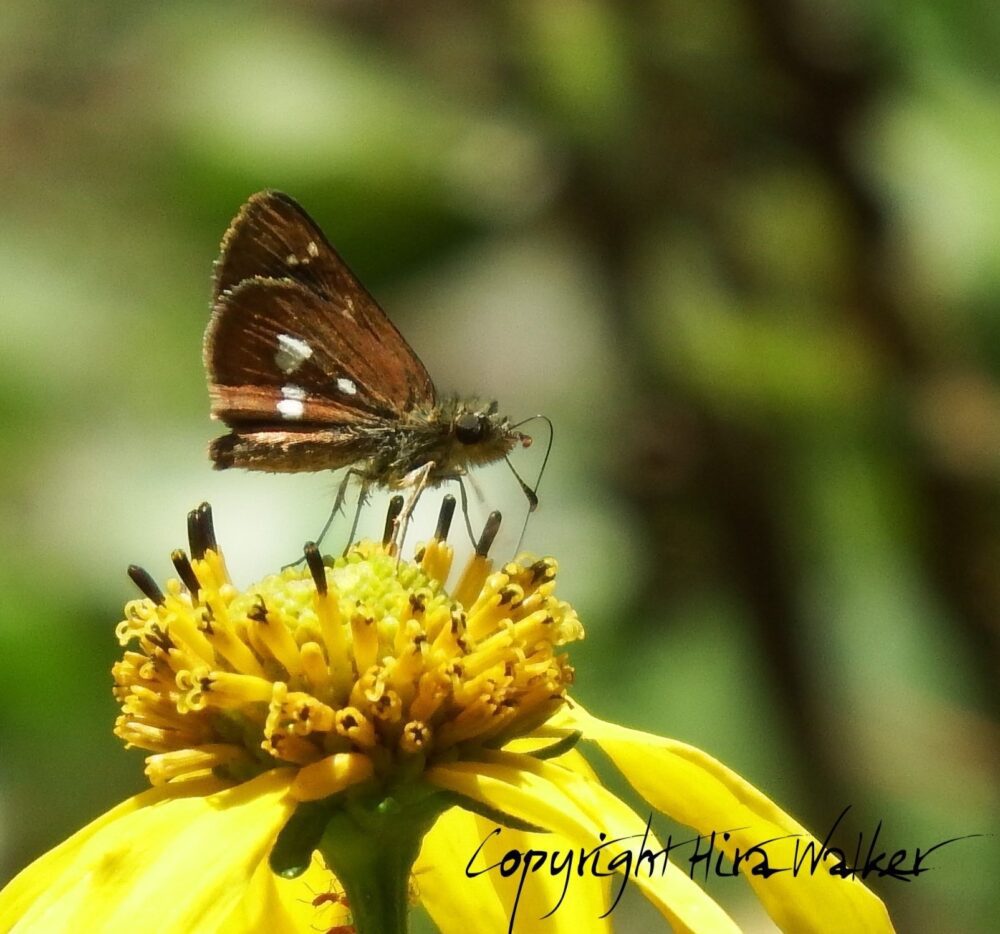
Elaine makes a good point, that butterflies were not uniformly abundant after monsoon rains. That was my observation, too, during the Sugarite Butterfly Festival in late July. There were massive blooms of flowers including familiar and reliable butterfly attractors such as beebalm (Monarda fistulosa) and cutleaf coneflower (Rudbeckia laciniata). The butterflies, on the other hand, were disappointing. Popular fan favorites like Aphrodite Fritillary (Argynnis aphrodite) and Raton Mesa Fritillary (Argynnis hesperis ratonensis) were very few and very far between. And it wasn’t just the butterflies we missed; we also weren’t seeing other pollinators including bees, flies, and beetles. Droughts, especially the extraordinarily severe ones, can knock an ecosystem for a loop, temporarily we hope. These observations are consistent with my hypothesis that, in recovering from a very bad drought, the flora comes back pretty fast. Herbivores such as butterflies that eat those plants, however, may need another year — or another life cycle — of average or better precipitation to regain their pre-drought abundances.
And the recovery from drought or other major disturbances may not be equal across the board. During a mid-August visit to the Capitans and the lower east slopes of the Sacramentos, I hoped to see what had come from abundant rains that area received over the past couple of months. Sure enough, vegetation was luxuriant, green, even in the desert. There were quite a few butterflies, too, though not in the same luxuriant quantities. Particularly curious were the odd gaps, both taxonomically and topographically. For example, there were no species that typically find mates by patrolling drainage bottoms – you know, the buckeyes, roadside-skippers, orange skipperlings. I suppose a couple of good gully-washers could have created that butterfly void by scouring the channels well up the banks, as visual evidence suggested. Then there was the odd absence of Hesperiine (grass-feeding) skippers. Taxonomically they comprise almost 20 percent of our fauna statewide. Grasses grew extravagantly where I was, but I saw only 1 individual from that subfamily: a female Green Skipper. It was a head-scratcher.
Although some butterfly species remain scarce, Monarchs, seem to be thriving. Almost everyone I talk to has seen one or more Monarchs this summer and, when I ask how that compares to prior summers, they all say there are way more this summer. July and August constitute breeding season for them as they focus their North American time on increasing their numbers. Places with abundant milkweed, and there seem to be plenty of those this year, that’s where the action is. In late July I visited Maxwell National Wildlife Refuge, where they have lots of showy milkweed (Asclepias speciosa) and horsetail milkweed (Asclepias subverticillata). In the span of a couple hours, I saw more than 20 Monarchs including one mated pair occupying the honeymoon suite in a Siberian Elm near Lake 14.
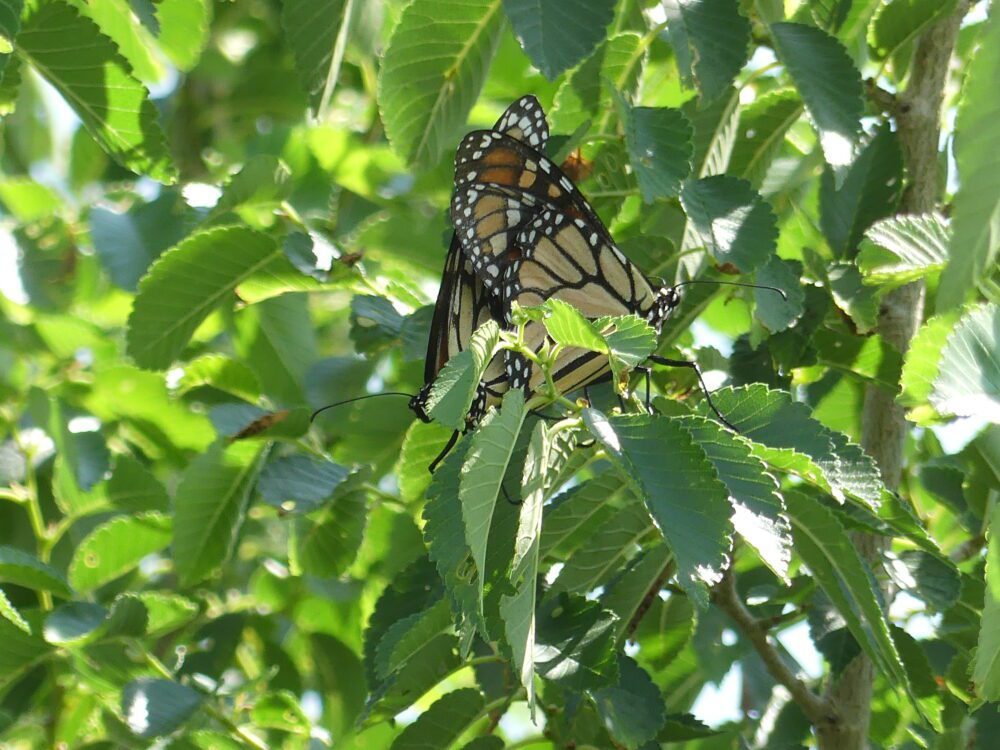
Rebecca Gracey and Joe Schelling came across a similar situation southwest of Socorro. On August 7, they saw 21 caterpillars and 12 adult Monarchs, including a mated pair, all stretched out along a 1-mile stretch of roadside where horsetail milkweed grew luxuriantly. Let’s hope the mowing crews don’t get there until after the first killing frost, or there could be massive Monarch caterpillar mortality.
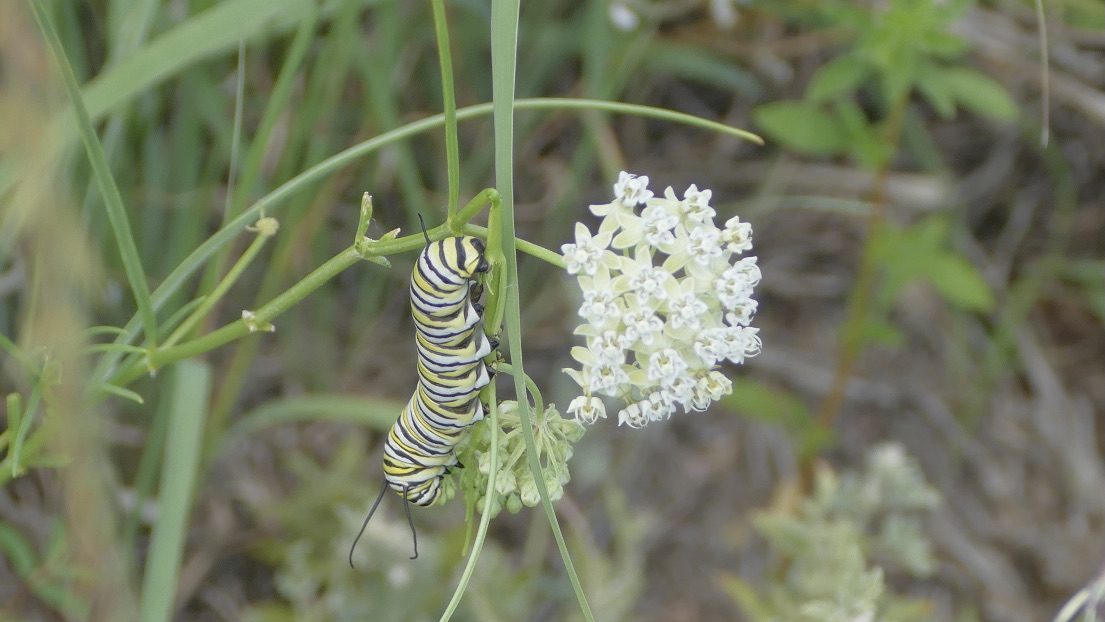
Hira Walker and her naturalist kids, Brooke and Chance, had a similar encounter while exploring the north slope of the Jemez Mountains above Youngsville. Said Hira, “it seems to be a very good year for milkweeds and monarchs. We returned to that population that Brooke found near Youngsville and I counted 21 caterpillars and 5 eggs. The caterpillars were all quite small, but there was some variation in age with some newly emerged and others about 1 cm long. The area was a little trampled by elk, but most of the milkweed was unharmed. I adventured along the little creek further from that spot and found 3 other very small patches of the same milkweed, but, unlike our patch — which is large and in the shade, these patches were small and in the sun. They did not have any monarch eggs or caterpillars. We hope to go back to the site . . . to find chrysalises (we might even experiment with using a black light at night) and then later to find some newly eclosed adults to tag.”
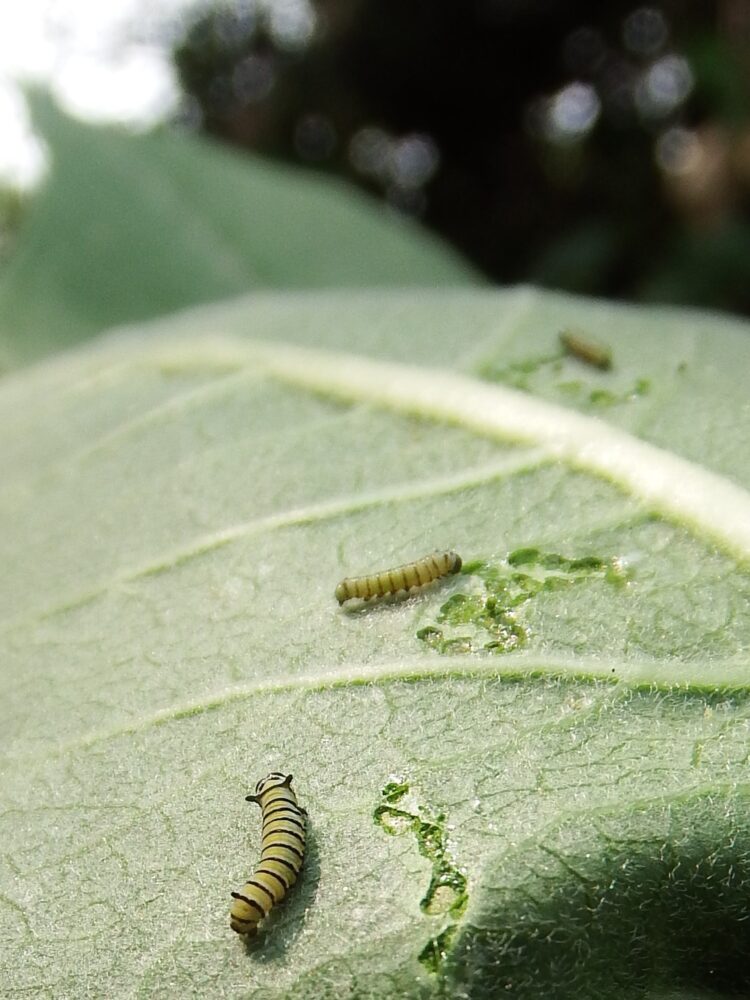
Monarchs are likely to fill increasing amounts of blog space as we get into autumn migration season. Do you have any cool Monarch photos or stories to share? If so, please let me know (sjcary@centurylink.net) and I’ll try to get them into the next couple of posts. Meanwhile, please continue to post your Monarch sightings to Journey North. We want New Mexico to look good on that and other citizen science platforms!
Until next month . . . Happy Butterflying!

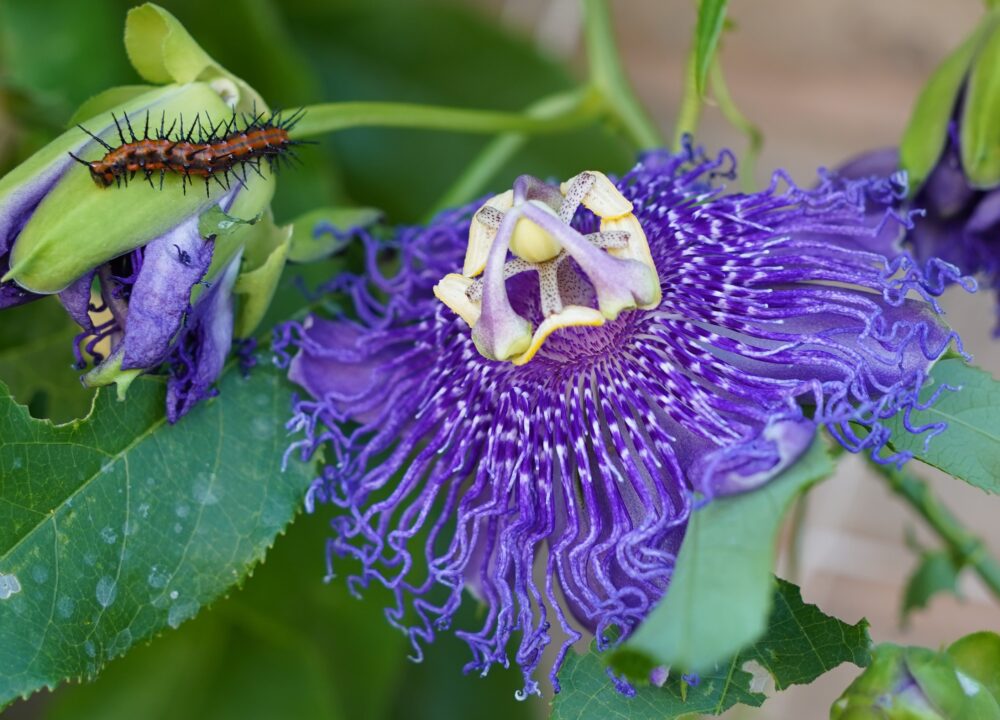
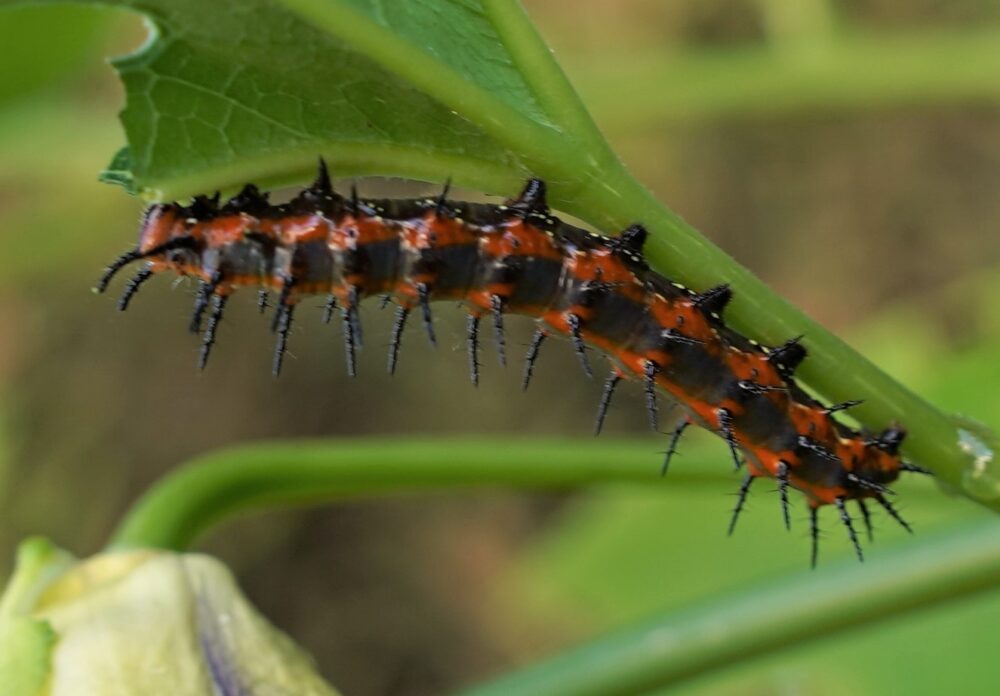
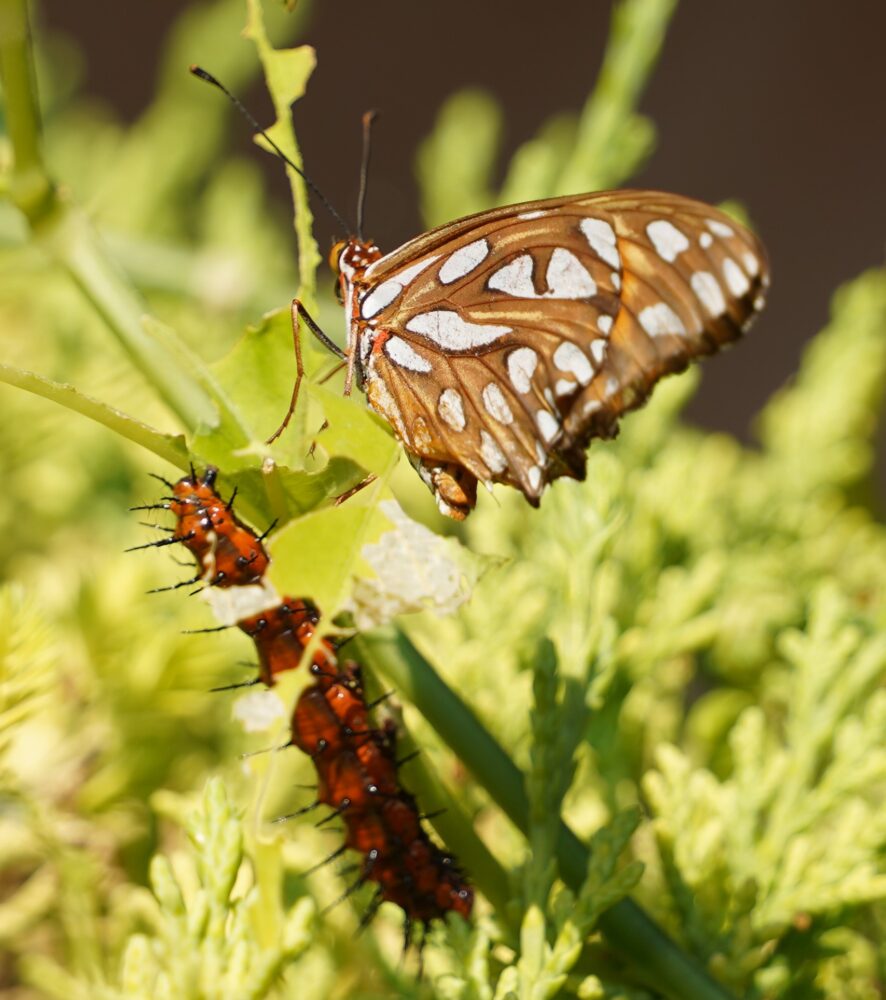
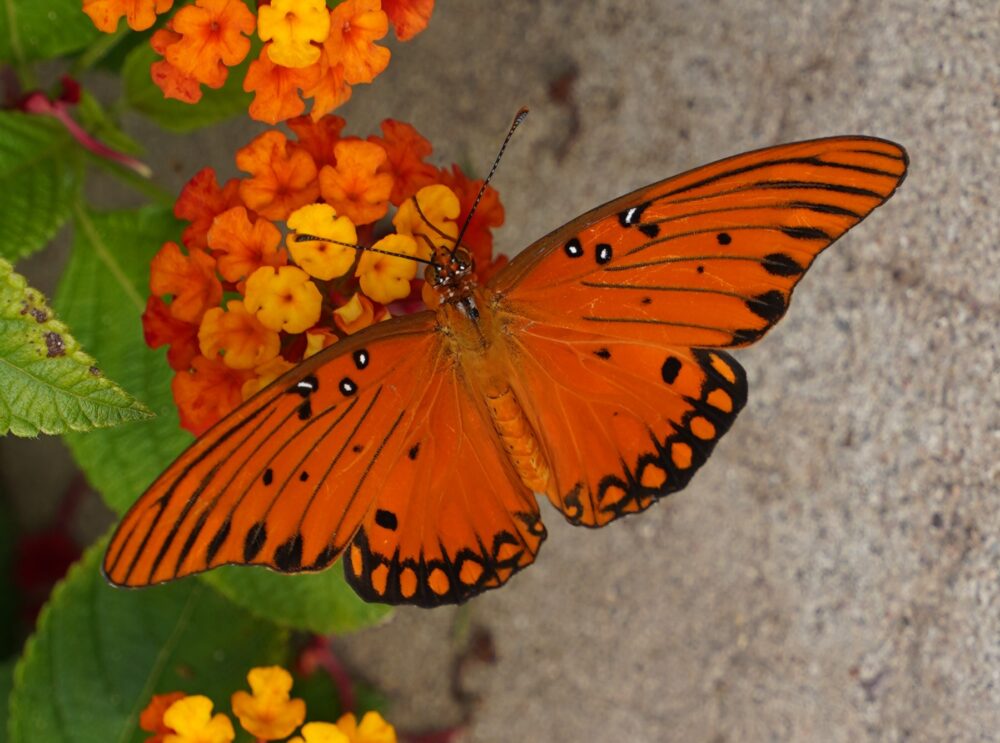
Another excellent post, Steve. Thanks for sharing all those stories.
So glad to hear of more Dotted Checkerspot sightings. I have friends from MA and FL who want to see it.
Very interesting post with excellent photos and amazing sightings! The Florida White is beautiful; I’ve never seen one. The Indra sightings and pictures are neat–makes me wonder if it’s double brooded there (maybe there’s also a spring brood in that location). It’s great to have all the “eyes” out there reporting what they find!
You are so right about the explosion. I thought for a while there wouldn’t be any butterflies this year. Then came the rains. Then it rained some more. Suddenly they are everywhere! In Albuquerque NE and South Valley we are seeing lots of Monarchs and Queens. The milkweed looks good too lots of food for the next gen.
The Florida White was really cool. And the aberrant swallowtail. Who knew? Very neat.
Love reading about Las Cruces area. Please keep up the blog and all the great pictures. The Florida White was a special treat, thanks!